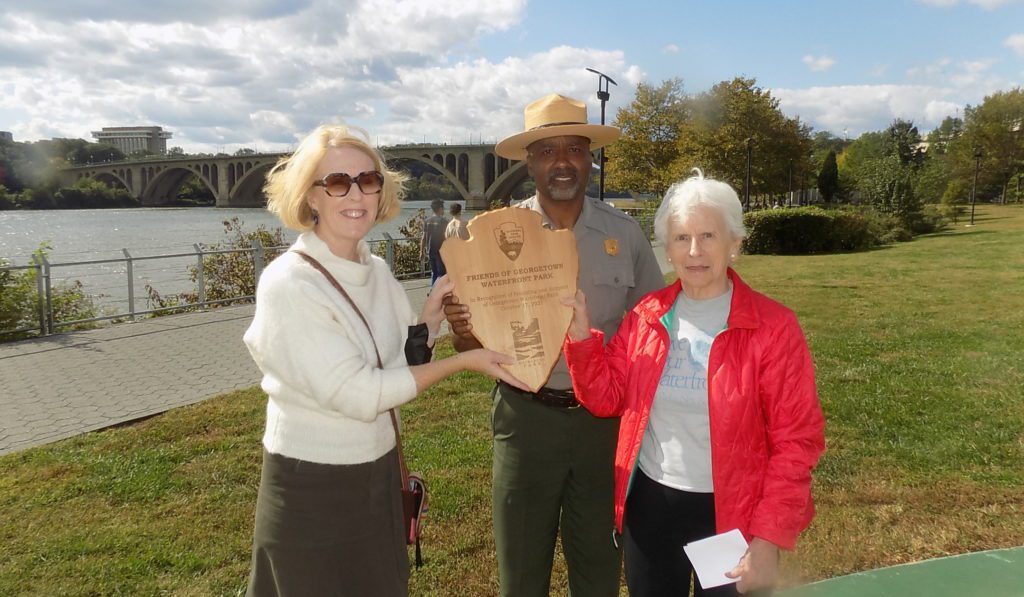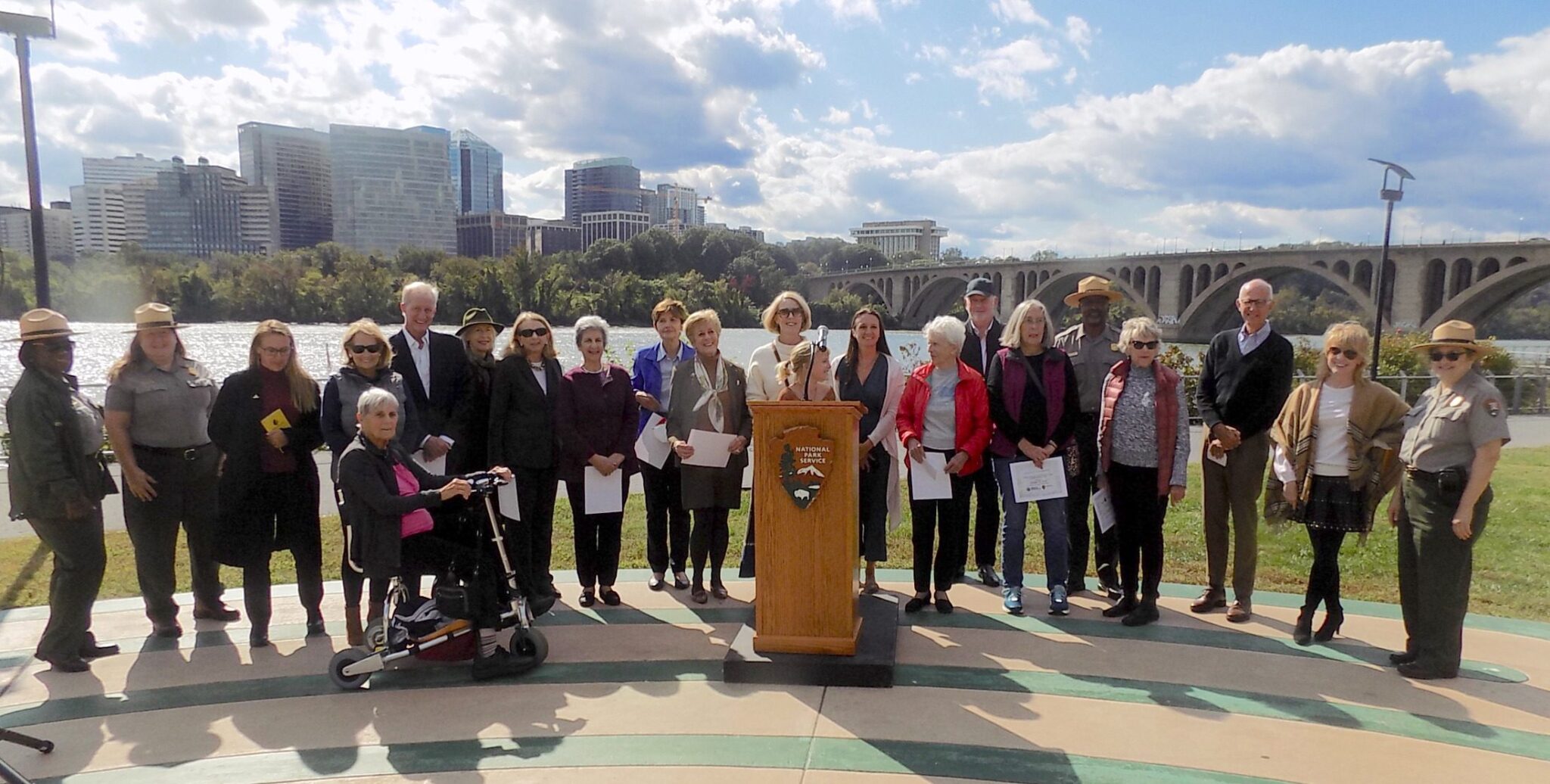Park Service Salutes Friends of Georgetown Waterfront Park
By • October 18, 2021 0 1457

For those who longed to fix up the Georgetown waterfront with its parking lots, salt dome and other eyesores, it was decades in the making. After being a port and an industrial area, the shoreline of the Potomac River at Georgetown finally become a public park 10 years ago, thanks to the nonprofit, Friends of Georgetown Waterfront Park. The park is administered by the National Park Service.
On Sunday, Oct. 17, at a founders day celebration, the NPS said happy birthday to the group of steadfast Georgetowners who raised the funds to make Georgetown Waterfront Park a reality in 2011. Accepting the plaque from Rock Creek Park Deputy Superintendent Frank Young were Meg Hardon, president of Friends of Georgetown Waterfront Park, and Ann Satterthwaite, co-founder of the group — along with friends, supporters and other co-founders.
The Park Service and Friends of Georgetown Waterfront Park are an excellent example of a private-public partnership, both agreed, allowing for the continued maintenance and improvement of the well-used and well-loved green space — from Washington Harbour to 34th Street — along the river in the oldest neighborhood in the nation’s capital.

Along with the National Park Service, board members, friends and supporters celebrate the founding of Georgetown Waterfront Park, now 10 years old. Photo by Robert Devaney.
The following is a brief history of the long effort to build a public park on the waterfront from FOGWP:
In the 1950s, the District of Columbia planned to build two inner-loop freeways to funnel traffic around and through the central city. Part of the inner-most loop freeway was slated to run along the Georgetown waterfront.
To prepare for this project, the District acquired 10 acres of privately owned land along the Georgetown waterfront for the new roadway.
Over time, there was strong public opposition to both inner-loop freeway projects, causing the District to abandon plans to build these freeways in 1977.
After the inner-loop freeways were cancelled, the District cleared and paved the 10 acres of city-owned land along the Georgetown waterfront and used it as a public parking lot. A portion of the paved area was used to store city garbage trucks and road salt.
Recognizing this blighted waterfront land as a unique natural asset, in the late 1970s, Sen. Charles Mathias of Maryland established a regional task force to develop a plan for the Georgetown waterfront that would combine a public park with some development. Georgetown residents supported this plan, beginning a three-decade effort to transform the Georgetown waterfront into a public park.
The Four Waterfront Park Organizations
In 1978, Judy Bonderman, Ann Satterthwaite, and Katharine Sullivan formed the Committee for Washington’s Riverfront Parks, the first community organization formed to encourage the National Park Service to create a national park on the Georgetown waterfront.
To that end, in 1979, the Park Service signed an agreement with the owner of the last privately owned land on the Georgetown waterfront to provide a 60-foot-wide strip of waterfront land for public access to the river at what eventually became the Washington Harbour development. The agreement also provided for creating a small park along the waterfront between 31st Street and Wisconsin Avenue.
In the early 1980s, the District urged the National Park Service to create a larger waterfront park in Georgetown by offering to transfer 10-acres of waterfront land it had acquired for the freeway project to the Park Service in exchange for the Park Service’s promise to create a national park there.
The land transfer was completed in 1984, and in 1985 the Park Service prepared a conceptual plan for the waterfront park. But the plan was never implemented because the Park Service lacked the funds to build the park. Instead, the Park Service continued to use the waterfront as a public parking lot, and it allowed the District to continue to store garbage trucks and road salt there.
In 1991, Georgetown attorney Max Berry and Ginger Laytham of the Clyde’s Restaurant Group, formed a second organization, the Georgetown Waterfront Arts Commission, to broaden support for a national park on the Georgetown Waterfront by holding occasional cultural events there. The Arts Commission maintained public interest in creating a park on the waterfront, but funds for park construction were still lacking.
In 1994, Georgetown civic leaders formed a third organization, the Georgetown Waterfront Park Commission, to advocate for a park. The Commission was a coalition of volunteers and community organizations, led by Senator Charles H. Percy, a Georgetown resident and long-time park supporter, and Bill Cochran and Barbara Downs, former presidents of the Citizens Association of Georgetown.
The Commission raised some seed money for the park from the Federal Government and from private sources. But more than another decade would pass before there were sufficient funds to begin building the park.
In 1997, a small group of citizens who had been members of the Georgetown Waterfront Park Commission founded a fourth organization, the non-profit Friends of Georgetown Waterfront Park (FOGWP), to continue to advocate for the park and to complete the fundraising effort. FOGWP’s founding members were Grace Bateman, Barbara Downs, Gretchen Ellsworth, Jonda McFarlane, Ann Satterthwaite, Roger Stone and Bob vom Eigen.
Over the next several years, FOGWP raised a substantial portion of the funds needed to build the park. With the support of Ward 2 Council member Jack Evans, the District of Columbia Government contributed $10 million for park construction, and private donors, including the Sen. Charles H. Percy family, also generously contributed to this effort.
With these donations in hand, FOGWP was able to qualify for matching Federal funds, under the National Park Service’s Centennial Challenge Grant Initiative, enabling FOGWP to reach the $22 million fundraising goal.
In 2001, the National Park Service solicited proposals from nationally recognized landscape architects for the design of a park on the Georgetown waterfront. The noted Philadelphia landscape architect firm of Wallace, Roberts and Todd was selected, with Ignatio Bunster-Uster the lead landscape architect for the project.
The design for Georgetown Waterfront Park called for a passive park, featuring native plants, a natural bio-edge, rain gardens, a waterfront-promenade, river stairs, and an iconic fountain at the Wisconsin Ave. entrance to the park.
Groundbreaking for Georgetown Waterfront Park was held in July, 2006; Phase 1 (Wisconsin Avenue, N.W. to 34th Street, NW) opened in October, 2008, and Phase 2 (Wisconsin Avenue to Washington Harbour) opened in September, 2011, with a gala dedication of the entire park. Many of those who participated in the more than 30-year effort to build the park joined in the celebration.
Since Georgetown Waterfront Park was completed in 2011, thousands of residents and visitors have enjoyed the park each year. Led by current Board President Meg Hardon, FOGWP continues to work with the National Park Service to preserve and enhance Georgetown Waterfront Park, and to raise funds for this effort.

